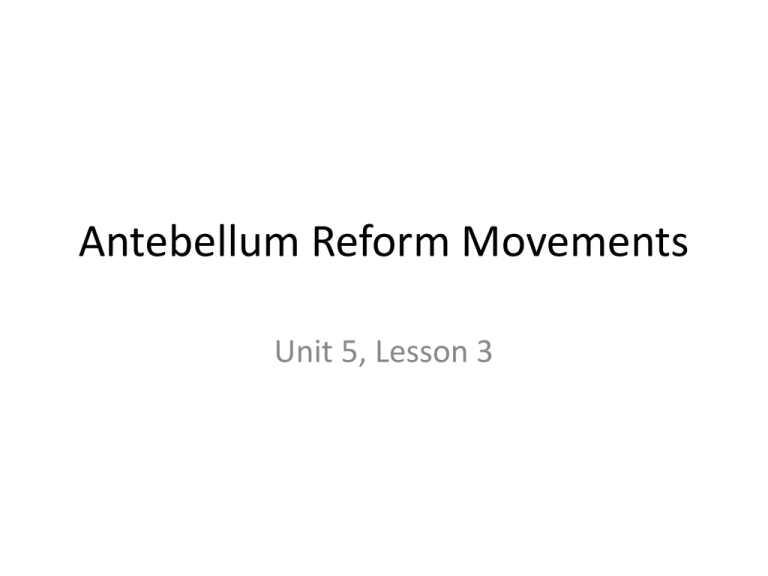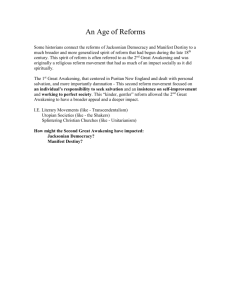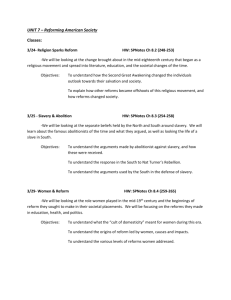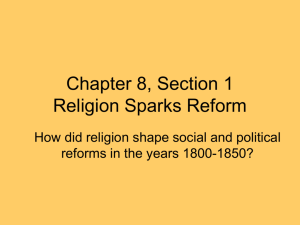Antebellum Reform Movements
advertisement

Antebellum Reform Movements Unit 5, Lesson 3 Essential Idea • The “Era of the Common Man” and the Second Great Awakening caused people to push for reforms. Era of the “Common Man” • • • • • • • • Event: Era of the Common Man Cause: Starting in the 1820s, universal white male suffrage spread Effects: Andrew Jackson, a “common man,” was elected Candidates had to campaign to appeal to common people The common man gained more influence in government Second Great Awakening • • • • • • • • Event: Second Great Awakening Cause: Americans were less religious, especially after the Enlightenment emphasized science and reason Effect: People looked to THEMSELVES to be saved, not church authority Common people had more influence in their religion Many wanted reforms to fix “sins” in society, especially slavery Antebellum Reform • • • • • Combined Effect: The country experienced a period of REFORM The Era of the Common Man gave people more power in government The Second Great Awakening gave people more power in religion Combined, people felt empowered to use the GOVERNMENT to REFORM “sins” in society • Issues to Reform: • Treatment of mentally ill, prison conditions, education, abuse of alcohol, and slavery • Women, also wanting more power, began pushing for equal rights Reforms: Mental Hospitals • • • • • Issue 1: Mental hospitals Reform: Dorothea Dix—exposed inhumane treatment of the mentally ill States created mental hospitals, not prisons, to give the mentally ill proper help Reforms: Prisons • • • • Issue 2: Prisons Reforms: Prisoners were treated inhumanely were sometimes jailed just for being in debt • Prisons began focusing more rehabilitating prisoners and “debtors’ prison” was abolished Reforms: Public Education • • • • Issue 3: Public education Reforms: Education was only affordable for the wealthy • Many believed the country could only survive if citizens were educated • Horace Mann—pushed for public, tax-supported schools with required attendance Reforms: Temperance • • • • Issue 4: Alcohol abuse Reforms: Many saw alcohol abuse as the root of society’s problems • Temperance— moderation of alcohol use • The American Temperance Society convinced many to reduce alcohol use and some states banned the sale of liquor • The Women’s Rights Movement • Effect of Industrial Revolution: • Roles of men and women changed during industrialization • Men and women had “separate spheres” • Men’s Sphere: • Men left home to work in factories • Men were active outside the home in politics and reform “True Womanhood” • Women’s Sphere: • Women stayed at home to care for the home and children • Women were not very active outside the home Reform: Women’s Rights • Women and Reform: • Women saw taking care of society as an extension of taking care of the home • Women resented men giving them secondary roles in reform • Women, like men during the “Era of the Common Man,” wanted more power in government and society Reform: Women’s Rights • • • • • • • • • Issue 5: Women’s Rights Events: Seneca Falls Convention—started the organized women’s rights movement in the United States in 1848 Declaration of Sentiments— declared men and women to be EQUAL Elizabeth Cady Stanton—demanded women’s SUFFRAGE (right to vote) Seneca Falls Convention Impact: The women’s rights movement was overshadowed by the biggest reform movement, abolitionism Reform: Abolitionism • • • • Issue 6: Abolition of Slavery Abolitionism: The abolition of slavery was the biggest and most divisive issue of reform • Tension over the issue of slavery contributed to the Civil War




